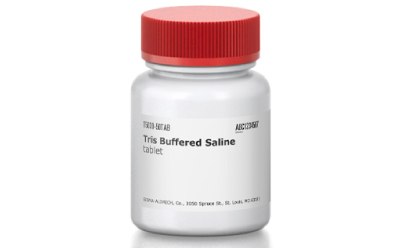Tris Buffered Saline (TBS)

Tris Buffered Saline (TBS) is an isotonic and non-toxic buffer solution that is often used in a variety of biological applications. TBS is composed of two key components: Tris and NaCl, where Tris acts as a buffering agent and NaCl regulates the tonicity of the solution, allowing it to be isotonic or hypertonic based on the desired concentration. TBS is user-friendly and can be easily mixed with water, making it suitable for many biological experiments.
Section Overview
Products
TBS WITH TWEEN 20
Tris Buffered Saline with Tween 20 is a non-ionic detergent that enhances the buffer's ability to elute and reduce the non-specific binding of antibodies. It is widely used in wash buffers for immune histochemical staining and in situ hybridization procedures, as it helps to minimize nonspecific background staining. Additionally, Tween 20 is an ideal combination of pH stabilizers, salts, and detergents that efficiently removes excess material from membranes and microtiter plate wells, without disrupting the antigen/antibody binding reaction.
TBS IN IMMUNOASSAY AND ELISA
TBS is used as a wash buffer in immunoassay, like enzyme-linked immunosorbent assay (ELISA), and helps in separating unwanted and non-specific proteins from specifically bound proteins.
TBS AS A BLOCKING BUFFER
Tris Buffered Saline (TBS) plays a crucial role as a blocking buffer in integrated microfluidic immunoassay chips designed for high-throughput sandwich immunoassay tests. It plays a crucial role in enhancing the assay's performance by reducing background noise and preventing non-specific binding.
TBS IN WESTERN BLOTTING
TBS is utilized in the preparation of antiserum and protein detection by western blotting in Nematostella vectensis. TBS is also used as a vital component to perform western blotting for the detection of Peanut Mottle Virus (PMV) and Peanut Stripe Virus (PSV) by saturating unbound sites on the nitrocellulose membrane, preventing non-specific binding of the primary antibody. This reduces background noise, improves sensitivity, and enhances the specificity of the Western blot analysis for accurate virus detection.
TBS IN BIOMATERIALS STUDIES
Tris buffer is used as an ideal modified solution for investigating the degradation and apatite precipitation of Bioglass 45S5, as its chloride-free composition prevents interference with early-stage apatite formation. This advantageously facilitates the study of release kinetics and apatite precipitation in bioactive glasses.
To continue reading please sign in or create an account.
Don't Have An Account?